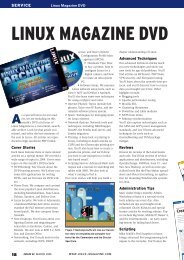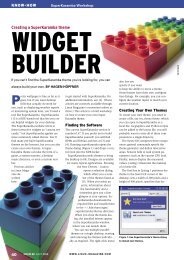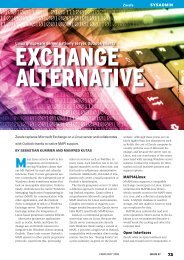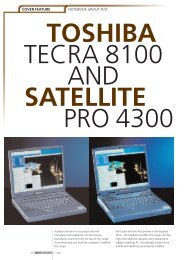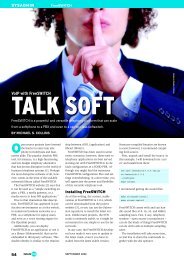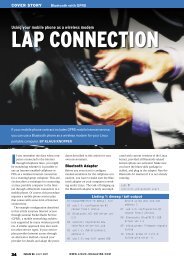64 Live CDs fstab KNOW-HOW 64 - Linux Magazine
64 Live CDs fstab KNOW-HOW 64 - Linux Magazine
64 Live CDs fstab KNOW-HOW 64 - Linux Magazine
Create successful ePaper yourself
Turn your PDF publications into a flip-book with our unique Google optimized e-Paper software.
<strong>KNOW</strong>-<strong>HOW</strong><br />
Klaus Knopper is the creator of<br />
Knoppix and co-founder of the<br />
<strong>Linux</strong>Tag expo. He currently<br />
works as a teacher, program-<br />
mer, and consultant. If you have<br />
a configuration problem, or if<br />
you just want to learn more<br />
about how <strong>Linux</strong> works, send<br />
your questions to:<br />
klaus@linux-magazine. com<br />
Ask Klaus!<br />
<strong>Live</strong> <strong>CDs</strong><br />
I have a laptop with a 3.06GHz<br />
Pentium processor, 512MB of<br />
memory, and a 40GB hard disk.<br />
The system came with Windows XP Pro.<br />
I resized the partition, created additional<br />
partitions, and installed Ubuntu 6.06<br />
with separate /swap and /home partitions.<br />
The system operates as expected.<br />
I find that some live <strong>CDs</strong> work and<br />
others don’t. For instance, the system<br />
works with live <strong>CDs</strong> for SUSE 9.2,<br />
Ubuntu 6.10, and several of the distros<br />
on the April 2007 <strong>Linux</strong> <strong>Magazine</strong> Small<br />
Distros DVD.<br />
The startup fails on live <strong>CDs</strong> such as<br />
Damn Small <strong>Linux</strong> 3.1 (startup hangs<br />
two lines after splash screen), DSL 3.2<br />
ASK<br />
KLAUS!<br />
DSL (there is nothing visible after booting<br />
from CD drive), Knoppix 3.6 (hangs<br />
after loading linux …), and the SUSE<br />
10.2 rescue disk.<br />
Can you tell me what is going on and<br />
how to fix it?<br />
If the boot process hangs immediately<br />
after you hit return, it’s<br />
almost certain that one of the<br />
following components won’t work correctly<br />
with your board:<br />
• ACPI<br />
• (L)APIC<br />
• PCI/ PNP access<br />
Some older boards will just hang when<br />
ACPI is on. Some newer boards will not<br />
work without ACPI, yet some don’t support<br />
parts of ACPI, so there is no real<br />
“safe” default.<br />
I have also seen some boards in which<br />
the built-in APIC controller freezes the<br />
system, and others in which accessing<br />
the PCI bus in direct mode fails to work.<br />
Again, no safe default exists. Many distributions<br />
just use default settings that<br />
“work on most boards.”<br />
<strong>64</strong> ISSUE 80 JULY 2007 W W W. L I N U X- M A G A Z I N E . C O M<br />
To see what’s wrong, try the following<br />
boot options after the name of the kernel:<br />
debug vga=normal loglevel=6<br />
This should give you a better hint as<br />
to where in the boot process the kernel<br />
stops dead. For fixing boot problems,<br />
I suggest trying one or many of the<br />
following options, separated by spaces.<br />
These options circumvent hardware<br />
problems in many common cases.<br />
• acpi=off (but in some cases, you<br />
even need acpi=force)<br />
• noapic (switches off APIC)<br />
• nolapic (turns off local APIC, which is<br />
really a different option from noapic)<br />
• pnpbios=off (disable ISA plug and<br />
play, which hangs on some boards<br />
even if they don’t have an ISA bus)<br />
• pci=bios (use BIOS settings for PCI<br />
setup/ access; might work if the default<br />
direct method fails)<br />
• irqpoll (known to fix really strange<br />
IRQ problems, mostly related to SATA<br />
controllers)<br />
You’ll find a description of these options,<br />
plus many other boot options, in the kernel<br />
documentation under /usr/src/linux/<br />
Documentation/kernel-parameters.txt,<br />
which is also available at www. kernel. org.<br />
<strong>fstab</strong><br />
I have a problem that only occurs<br />
on Knoppix 4.0 and later<br />
and not on any other distros. On<br />
live disk boots, <strong>fstab</strong> comes out incorrectly.<br />
I have the following drives on a<br />
Win98/ XP dual boot:<br />
hda1=C: (win98) fat32<br />
hda5=E: fat32
hda6=F: fat32<br />
hda7=G: fat32<br />
hdb1=D: WinXP, NTFS<br />
hdb5=H: fat32<br />
hdb6=I: fat32<br />
hdb7=J: fat32<br />
hdb8=K: fat32<br />
hdb9=L: fat16.<br />
Knoppix v4.0 and after reports hda6<br />
and hda7 as ext2 and ext3, respectively.<br />
I wonder what changed from v3.3 to v4<br />
and later.<br />
How do the later versions determine<br />
what to write when creating <strong>fstab</strong>?<br />
I can always automatically just go in<br />
and edit <strong>fstab</strong> after booting, but it bugs<br />
me that I can’t figure out what must<br />
have a very simple answer.<br />
It surely is a bug, but not an obvious<br />
bug, and I wonder if your<br />
hard disk partitions were once<br />
formatted with ext2 or ext3 before they<br />
were reformatted with fat32.<br />
To get a quick overview of what the<br />
Knoppix filesystem detection finds, you<br />
can use the scanpartitions command as<br />
root. Knoppix tries to detect the filesystem<br />
type with the command:<br />
file -Lkbs /dev/partitionname<br />
and if that does not show any usable<br />
results, the fstype script checks for wellknown<br />
filesystem labels in the first few<br />
blocks of the partition.<br />
I did not find a faster method yet, but<br />
maybe parted would be more reliable.<br />
You can also type:<br />
sudo file -Lkbs /dev/hda2<br />
to see what the file utility thinks your<br />
second partition on the first drive contains.<br />
I’m very interested in the results, so<br />
could you please email me the output of<br />
the sudo file -Lkbs /dev/hda* commands,<br />
as well as sudo parted /dev/hda print?<br />
1280x1024<br />
I enjoy your articles in <strong>Linux</strong><br />
<strong>Magazine</strong>. Here’s a question:<br />
Could you explain why Knoppix<br />
and Ubuntu have difficulties with<br />
hardware detection of Intel 845G series<br />
graphics chips and 17-inch 1280x1024<br />
resolution? SimplyMEPIS, Mandriva,<br />
Puppy, … boot right up.<br />
Three of the five computers<br />
on our LAN have Intel<br />
Graphics: IBM ThinkCentre,<br />
IBM NetVista, and a Super-<br />
Micro board.<br />
The ThinkCentre has a<br />
Sony 15-inch 1024x768<br />
LCD, and Ubuntu crashes in<br />
normal boot.<br />
I think Knoppix came up<br />
on that with only 800x600;<br />
however, it is someone<br />
else’s computer, so I didn’t<br />
experiment with it.<br />
Yes, safe graphics mode<br />
works, slowly – especially<br />
the scroll wheel.<br />
And yes, sudo dpkg-reconfigure<br />
xserver-xorg works,<br />
but ordinary desktop computer<br />
users do not want to<br />
enter that command on<br />
every CD live boot.<br />
By the way, this is Puppy, which gives<br />
the option of storing changes and files<br />
on USB or hard disk; in this case, it’s a<br />
file on the NTFS-formatted XP filesystem.<br />
Maybe by luck or design, XP<br />
doesn’t seem to mind.<br />
I built a USB live Knoppix as described<br />
in your March 2007 article (thanks!);<br />
however, these machines don’t boot<br />
from USB. I have a setup with Puppy<br />
USB <strong>Live</strong> that uses a diskette to bootstrap<br />
in. Maybe I can look at that diskette<br />
or Lilo or something to bootstrap<br />
into Knoppix?<br />
The way Knoppix finds out<br />
which resolution to use is quite<br />
strange, but it attempts not to<br />
break anything. If graphics card and<br />
monitor both report that they can work<br />
with resolutions larger than 1024x768,<br />
the resolution that the monitor reports<br />
via DDC as the “preferred” mode will be<br />
taken. Some monitors report frequencies<br />
that are simply wrong and won’t work in<br />
this mode. Then, the next lower mode is<br />
being used.<br />
Some monitors (like most notebook<br />
displays) don’t report any capabilities<br />
at all. For these, the default “safe”<br />
1024x768/ 80Hz mode is used.<br />
Frequently, you see this with notebook<br />
displays, even though the graphics<br />
adapter claims it can do more than that.<br />
If you like, you can just set a much<br />
higher resolution with the screen=<br />
W W W. L I N U X- M A G A Z I N E . C O M<br />
Ask Klaus!<br />
<strong>KNOW</strong>-<strong>HOW</strong><br />
parameter, and then the limiting factor<br />
is only the frequency, which can also<br />
be set by the hsync= and vsync= boot<br />
options.<br />
My excuse for this crude way of video<br />
detection is just that I don’t want to<br />
break old monitors or ruin any eyes with<br />
adventurous graphics modes. Many<br />
other distros are less conservative and<br />
probably have a better way of getting<br />
good resolution on newer hardware.<br />
About your second question: A Knoppix<br />
5.1 boot floppy is not easy to create<br />
because kernel 2.6 and initrd won’t even<br />
fit on two floppies anymore. I’m still<br />
searching for a way to use a small kernel<br />
on a floppy for only CD-ROM detection,<br />
and then use kexec to start a new kernel<br />
from a mounted CD or USB stick.<br />
MySQL and Apache<br />
When I run Knoppix 5.0.1 or<br />
5.1.1 on my normal system,<br />
everything seems to work fine,<br />
but when I shut down, the unionfs<br />
seems to take two or three minutes before<br />
it finally shuts down.<br />
This concerns me regarding potential<br />
issues with my hard drive. The partitions<br />
are ext3.<br />
ISSUE 80 JULY 2007<br />
65
<strong>KNOW</strong>-<strong>HOW</strong><br />
I’ve notice some other systems don’t<br />
have this issue. I still use the Knoppix<br />
3.6 version daily, and I have set up some<br />
very simple scripts to get MySQL and<br />
Apache to use directories on my hard<br />
drive after booting from CD-ROM.<br />
This makes a great development environment<br />
for me. I was going to do that<br />
with 5.1, but it seems that there are only<br />
a few traces of MySQL, so I assume it<br />
was removed to make room for other<br />
things. Maybe it is on the DVD; I haven’t<br />
checked because the DVD seems to boot<br />
much slower.<br />
I played around with remastering 5.01,<br />
but every task that needs a root password,<br />
including changing the time,<br />
won’t work with the old method of<br />
setting the root password in a terminal<br />
window first.<br />
It seems that ksudo doesn’t use the<br />
passwd file. Is there anything I should<br />
avoid in the remaster process that affects<br />
ksudo?<br />
You are right; kdesu is no longer<br />
asking for a root password in<br />
the live CD or DVD, and it uses<br />
the sudo command instead. You would<br />
have to edit /etc/sudoers to include the<br />
user who should run kdesu tasks without<br />
a password. You can revert to the old<br />
method by removing the user-specific<br />
kdesu config file:<br />
rm -f /home/*/.kde/shareU<br />
/config/kdesurc<br />
The reason why unionfs is sometimes<br />
taking awfully long to umount is yet unknown<br />
to me, but this problem is very<br />
annoying.<br />
I’m also investigating this. In any case,<br />
I’m quite sure that your hard disk isn’t<br />
broken because the problem also happens<br />
with USB sticks and various hard<br />
disks. To be sure that all data arrives on<br />
disk, you can enforce a filesystem sync<br />
by pressing the magic sysrq key combination,<br />
Alt+Print+S, before power-off<br />
or reset.<br />
MySQL is still present on the DVD,<br />
which should not be much slower than<br />
the CD because the read data rate of a<br />
Send your <strong>Linux</strong> questions to<br />
klaus@linux-magazine. com.<br />
Ask Klaus!<br />
DVD is actually higher than that of a CD.<br />
Seek times can be slower, but this depends<br />
on your DVD drive type.<br />
Dell 410 and Closed Lid<br />
I read your article in <strong>Linux</strong> <strong>Magazine</strong><br />
about ACPI and APM. I<br />
have not had luck with keeping<br />
the display enabled on a Dell 410 once<br />
the cover is closed and then reopened.<br />
Currently, I am running ACPI and using<br />
Mandriva 2007.0 with either the<br />
2.6.17.14-mm-laptop-3mdv or 2.6.17-<br />
5mdv kernels. I can ssh into the laptop<br />
from another system.<br />
Running init 3 then init 5 remotely<br />
on the laptop does not seem to turn the<br />
LCD display back on. The only option<br />
seems to be to reboot the laptop.<br />
Running /etc/init.d/laptop_mode status<br />
returns the correct lid state and even<br />
returns the correct state of the lid if the<br />
LCD display has gone out due to closing<br />
the lid.<br />
We tried a Knoppix 5.0 DVD on a Dell<br />
410, let it boot up, and then closed the<br />
lid. We got the same result – the display<br />
on the LCD goes away, yet the system is<br />
still up and running.<br />
Would you have any suggestions for<br />
how to fix this?<br />
It would be interesting to know<br />
if this problem happens<br />
in both Xorg<br />
and console mode. I think it<br />
is a hardware design error if<br />
a display turns off automatically,<br />
but not on again when<br />
the lid button is released. But<br />
in any case, you can probably<br />
fix the problem by installing<br />
an ACPI event handler that<br />
will switch on the display as<br />
soon as a “lid opened” event<br />
is detected.<br />
For this, you first install a<br />
config file /etc/acpi/events/lid<br />
for acpid that will trigger an<br />
01 #!/bin/bash<br />
02<br />
event handler. You also might want to<br />
check for any existing handlers:<br />
event=button[ /]lid<br />
action=/etc/acpi/actions/lid.sh<br />
Now, to create a /etc/acpi/actions/lid.sh<br />
that will do the right thing, you need to<br />
find a tool for switching on the light. My<br />
best guess for your notebook type is<br />
vbetool (http:// freshmeat. net/ projects/<br />
vbetool/), so if it is not already on your<br />
system, please install it.<br />
You can check to see whether it’s<br />
working by running vbetool dpms on in<br />
an open shell after closing and opening<br />
the lid. It works for me. In case of<br />
success, you could then create an ACPI<br />
action script similar to Listing 1.<br />
Don’t forget to make the script executable<br />
with:<br />
chmod 755 U<br />
/etc/acpi/actions/lid.sh<br />
and restart acpid with /etc/init.d/acpid<br />
restart. Now the script should start automatically<br />
every time the lid button is<br />
pressed or released, and if it is released,<br />
the script will start vbetool to put the<br />
light back on. ■<br />
03 if grep -q open /proc/acpi/button/lid/*/state 2>/dev/null<br />
04 then<br />
05 /usr/sbin/vbetool dpms on<br />
06 fi<br />
66 ISSUE 80 JULY 2007 W W W. L I N U X- M A G A Z I N E . C O M<br />
Listing 1: /etc/ acpi/ actions/ lid.sh



